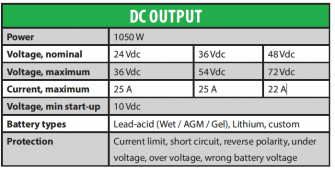Yes, That is frustrating.
A simple google search brought this up:
https://www.amazon.com/Lester-Summit-II-Battery-Charger/dp/B07N1WHXS6/
It is common (But often frustrating) for manufacturers to not have "Where to buy" info on their site. The reason for this is that they don't want to piss off any of their distributors by not listing them while they do list the competitors. It is simpler to not list the distributers than keeping the site up to date.
According to the datasheet, the
charge current is 22A for a 48V system.
View attachment 117960
For a 300Ah system, it would take 300Ah/22A=13.6Hr to charge from zero to full. In the original post
@MaximusAnonus stated a requirement for 30A so this may not be sufficient. However, this could be fine for other applications. Even if I am trying to arbitrage between peak power price and non-peak power price, this may be sufficient.




